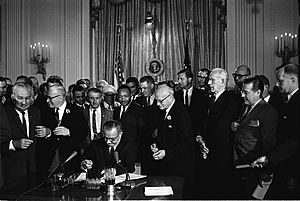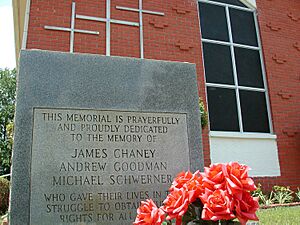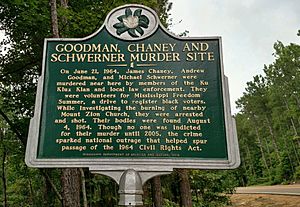Murders of Chaney, Goodman, and Schwerner facts for kids
Quick facts for kids Murders of Chaney, Goodman, and Schwerner |
|
|---|---|
| Part of the Civil Rights Movement | |
| Location | Neshoba County, Mississippi, U.S. |
| Date | June 21, 1964 |
| Deaths | |
| Perpetrators |
|
The murders of James Chaney, Andrew Goodman, and Michael Schwerner happened in June 1964. These three young men were activists working for civil rights. They were kidnapped and killed in Philadelphia, Mississippi. This event is also known as the Freedom Summer murders.
James Chaney was from Meridian, Mississippi. Andrew Goodman and Michael Schwerner were from New York City. All three were part of groups working for civil rights. They were helping African Americans in Mississippi register to vote. At that time, many states in the South made it very hard for black citizens to vote. They used unfair rules to stop them.
The three men had gone to a black church in Longdale. This church had been burned down. It was an important place for community meetings. On their way back, they were stopped by police for speeding. They were taken to the local jail and held for several hours.
After they left town in their car, they were followed. Their car was pulled over again before they left Neshoba County. The three activists were then taken to another place and killed.
Contents
The Search and Investigation
The disappearance of the three men was first seen as a missing persons case. Their burned car was found near a swamp three days later. A large search began. The Federal Bureau of Investigation (FBI), local police, and even 400 U.S. Navy sailors searched the area.
During the search, it became clear what had happened. Members of the local White Knights of the Ku Klux Klan were involved. Some people from the Neshoba County Sheriff's Office and the Philadelphia Police Department were also part of the crime.
National Outcry and Legal Action
The murders caused a lot of anger across the country. A big federal investigation was started. It was called Mississippi Burning (MIBURN). This name was later used for a movie about the events.
In 1967, the U.S. government charged eighteen people. They were accused of violating the civil rights of the three men. Seven people were found guilty. They received sentences that were not very long. The anger over these murders helped lead to the Civil Rights Act of 1964. This important law helped end discrimination.
The Ku Klux Klan murdered the trio because James Chaney was African-American. Andrew Goodman and Michael Schwerner were both Jewish.
Many years later, in 2005, one person involved, Edgar Ray Killen, was charged by the state of Mississippi. He was found guilty of three counts of manslaughter. He was given a 60-year prison sentence. In 2016, the case was officially closed. Killen died in prison in 2018.
Legacy and Honors
The sacrifice of Chaney, Goodman, and Schwerner is remembered in many ways. Their actions helped bring about important changes in America.
Individual Honors
National Recognition
- In 2014, Chaney, Goodman, and Schwerner received the Presidential Medal of Freedom. This is a very high honor given by the President of the United States. President Barack Obama awarded it to them after they had passed away.
Memorials in Ohio
- Miami University in Ohio has honored the three men. The university's Western campus has a memorial.
- In 2019, the university named lounges in three residence halls after them. This was to remember their bravery.
Memorials in Michigan
- At Cedar Springs High School in Cedar Springs, Michigan, there is an outdoor memorial theater. It is dedicated to those involved in Freedom Summer.
- The clock tower of the campus library is also dedicated to Goodman, Chaney, and Schwerner.
Memorials in Mississippi
- A stone memorial stands at the Mt. Nebo Baptist Church. It remembers the three civil rights activists.
- Several historical markers have been placed in Mississippi about this event:
- A marker called Freedom Summer Murders was placed in 1989. It is near Mount Zion United Methodist Church.
- Another marker, Goodman, Cheney, and Schwerner Murder Site, was put up in 2008. It was later damaged and replaced in 2013.
- The Old Neshoba County Jail marker was placed in 2012. It marks the spot where the three men were held.
Memorials in New York
- The Chaney-Goodman-Schwerner Clock Tower is at Queens College. It was built in 1988 and dedicated in 1989.
- New York City named "Freedom Place" in Manhattan after them. It is a four-block stretch in the Upper West Side.
- A plaque on 70th Street and Freedom Place tells their story. It was moved in 1999 to Hostelling International New York. This was so young people could see it.
- A stained glass window showing the three men is in Sage Chapel at Cornell University. It was placed there in 1991. Michael Schwerner had studied at Cornell.
Impact on Laws
- The murders helped lead to the passage of two very important laws. These were the Civil Rights Act of 1964 and the Voting Rights Act of 1965. These laws helped make sure that all people had equal rights. They also protected the right to vote for everyone.
In Culture
The story of Chaney, Goodman, and Schwerner has been told in different ways.
Film
- The 1988 film Mississippi Burning is loosely based on these events.
- The documentary Neshoba (2008) explores the investigation and the 2005 trial of Edgar Ray Killen.
Art
- Artist Norman Rockwell painted Murder in Mississippi in 1965. It showed the events to illustrate an article about civil rights.
Music
- Many musicians have written songs to remember the three activists.
- Tom Paxton included "Goodman, Schwerner, and Chaney" on his 1965 album.
- Pete Seeger and Frances Taylor wrote "Those Three are On My Mind".
- Phil Ochs wrote "Here's to the State of Mississippi" about these events.
- Simon & Garfunkel's song "He Was My Brother" is often linked to Andrew Goodman.
See also
 In Spanish: Asesinatos de activistas pro derechos civiles de Misisipi para niños
In Spanish: Asesinatos de activistas pro derechos civiles de Misisipi para niños
Images for kids









